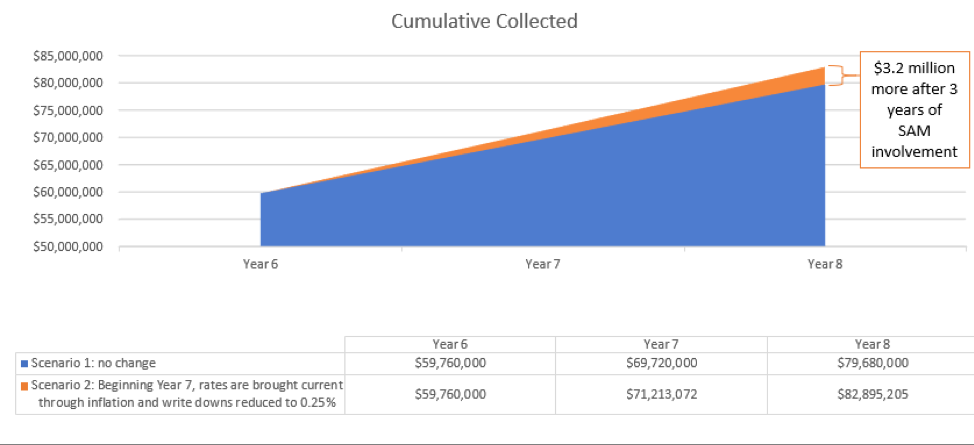Second of two blog posts by LawVision’s Steve Bell, Silvia Coulter and Yvonne Nath
In our previous blog post, we noted the emergence in the public accounting sector (and hopefully in the legal profession) of a new era of law firm business development and partnership with clients — Strategic Account Management or SAM-Legal©.
In this post, we explore expenditures and returns associated with hiring a dedicated businessperson to serve as Strategic Account Manager.
Costs
Most law firms already have invested heavily in the resources necessary to support business development initiatives, including aspects of SAM-Legal©. Already on the payroll are competent lawyers with relevant technical knowledge across legal disciplines and client service skills. Firms have made the investment in extensive research and business intelligence platforms that yield an understanding clients’ industries and the issues they face and must address. Budgets for lawyer travel and client entertainment often are already in place. Firms possess sophisticated systems to understand and analyze clients’ utilization of firm services and professionals, engagement trends, revenue and profit…and to spot emerging areas of clients’ needs. IT departments have invested in secure systems to communicate with clients and to facilitate sharing among client-service and client professionals. Most firms already have full-service marketing and business development functions that operate Client Relationship Management systems to identify the extent and strength of relationships with professionals at the client, and to map the journey of buyers of legal services. The in-place marketing and business development function also supports the development of client events, client-specific presentations and collateral, digital and social media connections, proposals, and the like. These items represent the bulk of what is needed to “do SAM.” Moving from Client Teams to SAM is substantially funded using existing resources and budgets.
True, there will be SAM-specific incremental costs, but they should prove relatively minor – items such as additional nonbillable attorney hours as SAM teams receive leadership and account training, prepare, organize, gather, conduct client and site visits, and operate generally.
We contend that the only material incremental expense related to the creation and operation of SAM rests with the hiring of the Strategic Account Manager, the high-level business professional described in our previous blog post. More than likely, this professional, who must bring a new and enhanced skill set, is not already on staff. The compensation of such an individual will, of course, depend on her or his experience, existing connections at the Strategic Account Client to be pursued, industry connections, and current and expected compensation. The good news for law firms is that such individuals exist at compensation levels well below the value they will bring, the revenue they will help to retain and grow, and the support they will provide to partners on sales strategy. Bonuses (since commission cannot be paid to a sales professional in a law firm) are based on a set of goals developed with the SAM professional as key targets are developed and a sales forecast is reviewed.
Returns
What can a law firm expect as return from its decision to invest in and deploy SAM? If lessons from the Big 4 are a harbinger, the returns include:
- Increased client satisfaction. After all, client professionals are part of SAM teams
- Expansion of services delivered and the geographies where they are delivered
- New introductions facilitated, including at subsidiaries of SAM clients
- Increased client wallet share and/or matter value (grow the client’s trust to earn the right to work on their more complex and valuable matters)
- Reduction in client attrition (client relationships can be expensive to replace)
- Reduction in the sales cycle
- Improved revenue at significantly higher than historic rates
- Improved efficiency and profitability
- Increased meaningful tenure of clients working with the firm (increased lifetime value of clients)
- Reduced fee pressure (although fee pressure will never dissipate entirely)
- Improved opportunity win rate
- Additional attorney hours made available from unfocused (i.e. not SAM) client development efforts
- Referrals by delighted clients to new prospective clients in the same industry
- Reduction in the volatility of a SAM client’s legal spend; more predictable, regular legal fees for existing work
- Improved rate realization (client asking for fewer discounts and challenging invoices less)
- Acceleration of attorneys’ sales readiness by being exposed to formal leadership, sales and account management training
- Growth opportunities for members of the SAM team
- Increased attorney engagement and wins in firm’s cross-selling activities
A hypothetical use case for a SAM and related high-level ROI analysis
Yvonne Nath of LawVision (Master’s Degree in Law Firm Management, former Director of Strategic Operations at Porter Wright, and an ROI enthusiast) has created this hypothetical use case for a Strategic Account Manager (“SAM”) with estimates of costs and benefits to help us imagine the financial impact to the firm of reaping just a few of the potential benefits of a SAM. Estimates of benefits have been kept artificially low for demonstrative purposes.
Background on the Client, the Firm, and their Relationship
The client is a publicly traded auto parts manufacturer. Five years ago, the firm agreed to offer this client a 15% discount on then-standard rates. At that time, the firm noticed a slight uptick in revenue from this client which has, on average, brought in about $10 million of revenue each year since.
The firm has 550 attorneys. Three years ago, the firm created a Client Team to serve this client. The team consists of the relationship partner (a Capital Markets specialist), other attorneys and paralegals from different practice areas, a pricing professional, a legal project manager, a marketing communications coordinator, and a technologist. This Client Team meets quarterly to share what they are working on for this client. Their goal is to have a holistic understanding of this client so they can better serve its needs. However, the firm has not seen a meaningful increase in new revenue since the Client Team was established. Earlier this year, the pricing professional tried to negotiate a rate increase or alternative fee arrangement with this client but the client was adamantly against revising the fee agreement at the time and even mentioned a forthcoming RFP to narrow down the list of firms on its preferred panel. The pricing professional backed off for the time being.
Lost Revenue Opportunity
As a result of static, once-standard (but now 5 years old) and discounted (15%) rates and write downs (2%) over the last 5 years for about the same routine portfolio of work, the firm has foregone about $10.2 million in revenue potential since the rate agreement was made. This is like performing a year’s worth of work for free!
More Reason to Change
The firm hired LawVision to conduct a client interview program to unearth issues and opportunities. Feedback from this client’s interview revealed several things, including but not limited to the following:
- The client works with several other law firms. Those firms also have client teams. Therefore, a client team is not a unique differentiator for this client and, frankly, this client is getting tired of being subjected to uncreative cross-selling attempts many of these client teams are making. However, one of the other firm’s client teams communicates frequently, brings a lot of value to the client, and seems to know the client better than the other firms. The client is thinking about sending that standout firm more work (which means the other firms will likely lose work).
- The client requests average write downs of 2% because, despite this Client Team’s best efforts, the client thinks that, compared to the aforementioned standout firm, this Client Team sometimes focuses on less important issues that the client does not believe are worth the fees.
These reasons explain why the pricing professional’s last rate discussion was unsuccessful; the client does not believe that this firm has provided additional value worth a rate increase or discount reduction and is thinking about giving more work to that other firm.
Trying Something New
By the end of Year 5, the firm makes a strategic decision to advance the client relationship. To do so, the firm hires a Strategic Account Manager (“SAM”). The SAM’s salary, benefits and overhead require an investment by the firm of $1,500,000 spread over the first 3 years – about $500,000 per year.
Minimum Viable Results (Base Case for a SAM in this Hypothetical Scenario)
We assume that our Strategic Account Manager and the client get off to a fast start in Year 6. The SAM doesn’t even have an office at the firm! The SAM spends 70% of her time installed in an office at the client’s where she sits within the legal department. She attends formal business unit and company-wide meetings and learns the root causes of many of the issues that the legal department is facing. She listens to shareholder calls and spends time reviewing quarterly and annual reports and department memos. As a perk of being so ingrained with the client, she often is invited to attend many informal meetings, which helps her bond with the client and learn plenty about the client’s goals, needs, and culture. Not to mention, she also has the advantage of learning about what other law firms are doing well and not so well according to the client. These insights are tremendously helpful to her Client Team.
The other 30% of her time she spends as follows: 25% around the firm, meeting with the Client Team, providing them with feedback and insights, and liaising with other attorneys and professionals throughout the firm to discuss industry and client-specific needs and opportunities that can draw upon their skills. She helps attorneys collaborate across practices to target other auto parts manufacturing companies the firm can serve. The other 5% of her time she produces public-facing thought leadership through blogs, speaking events and the like.
Toward the end of the SAM’s first year into the client relationship, this client’s satisfaction with this firm is such that the pricing professional is willing to revisit the fee conversation and the client actually agrees to allow the rates that were established 6 years ago to be brought current through inflation and to continue to track inflation each year for the next 3 years whereupon they will be open to having another fee conversation. It is agreed that a 15% discount off these inflation-tracking rates will still apply. This revised agreement is effective as of January 1 in Year 7.
In addition, the SAM has spent a good deal of time learning about the client’s strategic goals, daily and future challenges, and communications and service delivery preferences. The SAM has been disseminating these learnings within the firm and the firm has adjusted accordingly. The client appreciates the way this firm now identifies and prioritizes opportunities to help the them and, as a result, the client has reduced its average write down requests in Years 7 and 8 from 2% to 0.25%.
In our hypothetical scenario, based on the rate increases and write down reductions alone, by the end of Year 7 (at the conclusion of the SAM’s 2nd year with the firm), the firm has collected an additional $1,493,072 from this client which more than offsets the cost of the SAM by this point in time. Therefore, in Year 2, the firm surpasses its breakeven point on its investment in SAM and even sees a profit! By the end of the SAM’s 3rd year, in addition to covering her own costs, the SAM brought in about $1.7 million in profit to the firm.

Other Benefits Could Include, but Are Not Limited to:
Imagine if, as a result of better understanding the client’s strategic goals, the SAM facilitates collaboration within the firm to help attorneys and others provide more targeted solutions for auto parts industry clients (not just this 1 client).
On top of that, imagine that the SAM works with the information technologist and an outside vendor to help this client develop a custom solution to enterprise-wide contract management that allows the client to reduce the size of its legal department by 4 full-time people while also reducing its contractual risks. This custom solution inspires the client to send more work to this firm and less to other firms. By Year 8, as a result of these initial and many other additional benefits the firm has brought to the client through its tighter relationship (thanks to the SAM), the client sends an additional $4 million of new legal work to this firm.
The firm can take what it learned from customizing this contract management solution and adjust it so it can be rolled out to other clients. This improves the firm’s relationship with those other clients. Here is a nice example of leveraging existing resources for additional buyers instead of sinking major investment into a project for one buyer. (A separate ROI analysis could be performed to account for the costs and benefits of developing this custom solution then rolling it out to other clients, but you get the idea.)
These types of improvements in client relationship and revenue could not have been achieved for this firm if the SAM wasn’t spending 70% of her time at the client’s where she was able to pick up on opportunities and feedback the firm would not otherwise have had the time to capture. We are not even estimating the potential savings the SAM helped the firm achieve if the firm would have otherwise stayed the course, not involved the SAM, and watched the client reallocate some of this firm’s work to that other standout firm.
Another benefit that results from installing a SAM with a key client: time is freed up for attorneys to spend on billable work and build more business with new and existing clients. This, in turn, generates additional revenue and diversifies the client portfolio for the firm.
End Result?
The ROI to the firm of a SAM in this hypothetical case increased exponentially because the benefits this SAM brought to the firm had a butterfly effect. The SAM’s deep insights of the client’s specific needs and industry were shared within the firm which allowed others in the firm to win and develop similar clients and serve them well.
This scenario is hypothetical and guarantees no actual results of having a SAM at your firm. A SAM can benefit your firm in many ways, depending on how you design the role. The purpose of this hypothetical is to demonstrate that, if you compare different use cases for a SAM and perform an ROI analysis of each, these analyses will help you design a SAM role based on its highest and best use within your firm.
Who should shoulder the cost and reap the benefits of the SAM?
Whether the investment in a SAM should come out of the budget of the primary client relationship attorney(s), other attorneys, or the firm as a whole is up to your firm and will depend on how the SAM’s role is designed based on the expectations the firm has for the SAM. A detailed budget and plan should be put in place in advance of the SAM being brought on board. This will help the firm decide who will make the investment in the SAM and how the rewards resulting from the SAM’s efforts will be allocated.
Conclusion
Firms will be wise to invest in a SAM to build out SAM-Legal© teams for one significant reason (and many others as we’ve identified in these two blog posts). Firms have individual lawyer plans, practice plans, department plans, office plans and firm plans. A strong, well thought out SAM-Legal© strategy will be an umbrella that is all encompassing of a firm’s offices and practices



